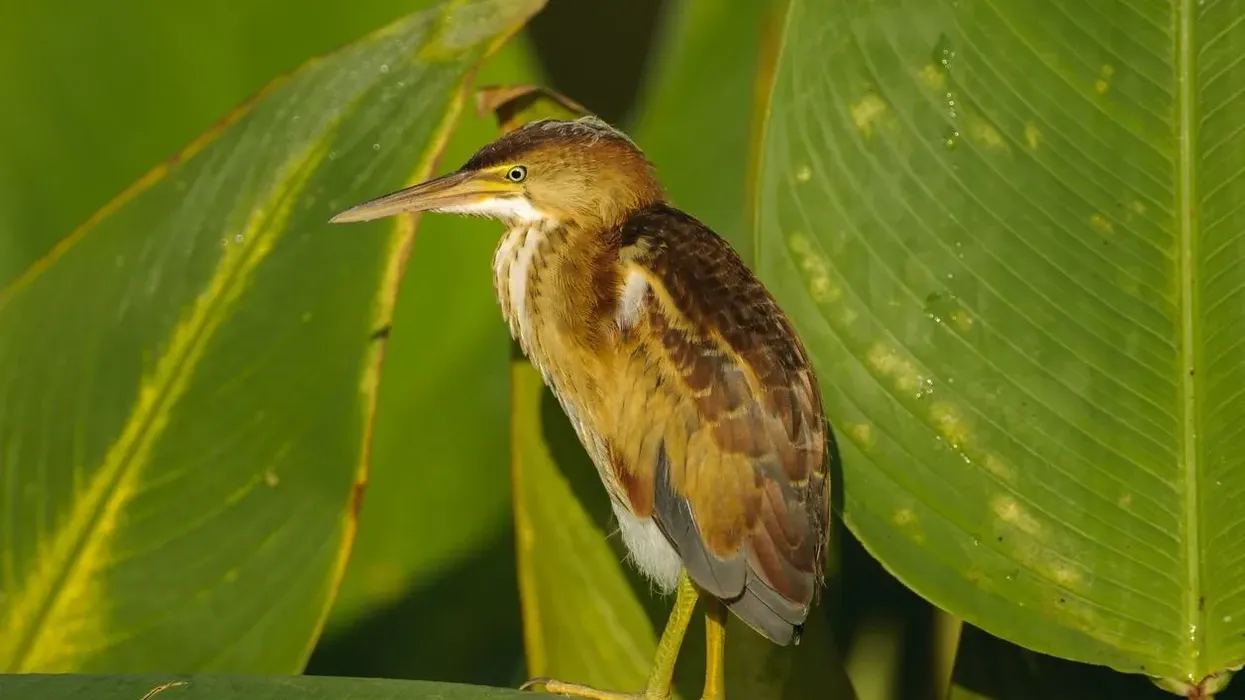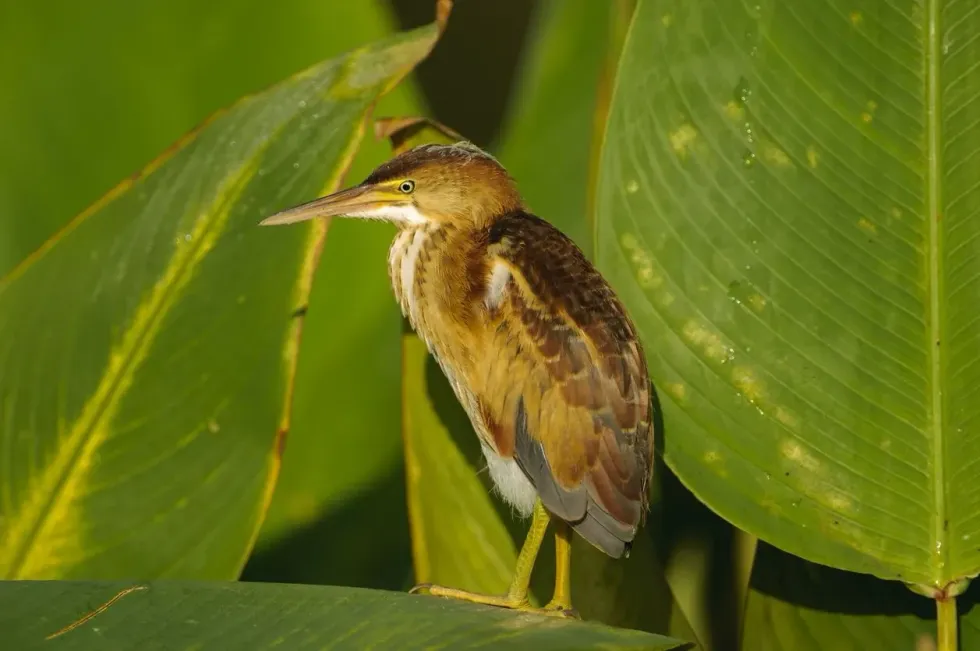Least Bittern birds are mainly North American birds and some of the world's tiniest herons living in deep marshes.
The Least Bittern climbs over cattails and reeds, sticking to the reeds with the long toes of its legs, rather than wading in the shallows like other herons. It can easily slide through thick, tangled, dense vegetation due to its narrow body.
It is rarely seen except when it flies due to its habitat preference, but its cooing and clucking call notes can be heard regularly at dawn and dusk, as well as at night.
In its preferred wetland habitat, this small heron is fairly common but secretive and easily overlooked. Its small size and elegant orange, black, and white pattern set it apart from other herons in its range.
The adult male has a darker coloration, while the Least Bittern female has a lighter coloration. It makes brief flights over the reeds on occasion. During the day and at night, listen to the gentle Least Bittern call, which is a 'coo' sound.
The elusive Least Bittern (scientific name: Ixobrychus exilis) is difficult to find, yet these tiny herons encourage persistence and will fascinate birders who persevere in tracking them down in their marshes. They're dressed tastefully in chestnut, buff, and purple, with the male being darker than the female.
Even though drainage and expansion of wetlands have depleted their numbers, the Least Bittern can still be seen in most of their historic range and are most visible during the breeding season.
If you like reading this, then you must also have a read of pintail and crane facts.
Least Bittern Interesting Facts
What type of animal is the Least Bittern?
The Least Bittern is a species of small heron bird.
What class of animal does the Least Bittern belong to?
The class of animal Least Bittern bird species belongs to is Aves.
How many Least Bitterns are there in the world?
The exact status of the population of this species of bird is unknown.
Where does the Least Bittern live?
The Least Bittern (Ixobrychus exilis) lives in the wetlands (cattail marshes) of New York. It can be found in marshes with a combination of open water and trees, often with cattails, phragmites, or lily pads, in most of North and South America, typically seen motionless poised on top of reeds at the water's edge.
Least bitterns are uncommon breeders in coastal and freshwater wetlands, but they can be found largely in areas where food is plentiful.
Few birds tend to look for food in the salt marshes and mangrove swamps throughout the season. Least Bitterns spend the winter in wetlands with saltwater, brackish water, and freshwater in the southernmost coastal areas of the least bittern range in the United States (especially southern Texas and Florida) and Mexico, the Caribbean, and Central America.
In the winter, they frequently use artificial wetlands such as golf course ponds or water treatment areas of New York or Florida with reedbeds.
What is a Least Bittern's habitat?
The Least Bittern habitat consists of coastal and brackish marshes with dense cattails and other plants. Nests are normally dispersed across the wetlands, but they may form loose colonies.
In one sample in South Carolina, Least Bitterns often nested alongside boat-tailed grackles. The location of the nest is well hidden in the dense marsh vegetation. Their nest is a foundation made by bending down marsh vegetation and adding sticks and grass on top (mostly constructed by the male).
Who do Least Bitterns live with?
Information on how the population of this bird species tends to live is unavailable, but they sometimes live in groups called flocks.
How long does the Least Bittern live?
The life span of a Least Bittern bird species is up to 10 years.
How do they reproduce?
Least Bitterns arrive at their breeding grounds in late May or early July and begin forming pairs. These couples will build solitary nests in the marsh that are either close to the ground or hung above the water on a platform consisting of reeds and other grasses folded over before breeding.
Females normally only have one brood per season and lay two to seven eggs per brood. Males and females remain on the eggs for 17-20 days, incubating them before they hatch.
The young juvenile Least Bittern spends 5-17 days in the nest after hatching, feeding mainly on regurgitated food. Adult males are mainly responsible for feeding the young ones.
What is their conservation status?
The conservation status of the Least Bittern (Ixobrychus exilis) is Least Concern.
Least Bittern Fun Facts
What do Least Bitterns look like?
The Least Bittern has a size that of a small bird, reaching a maximum height of 1 ft (30 cm) and a wingspan of up to 17 in (43 cm).
Some of the identifying characteristics of the Least Bittern are that this bird has a greenish-black crown, back, and tail feathers, while the Least Bittern's neck, arms, and underbelly are white and brown with vertical stripes.
Its wings are chestnut in color with lighter spots. It has green on the front of its legs and yellow on the back and bottoms of its feet.
Least Bittern birds have darker streaking patterns on their chests and neck and a faint purple tinge on their crowns, backs, and tails in female birds and juvenile (young) or immature Least Bittern birds.
How cute are they?
The least bittern is a very cute bird, mostly attributed to its small size and melodious coo (Least Bittern song). Their colorful body, such as the neck, back, wings, and long toes, add to their beauty. Least bittern babies, too, are adorable.
How do they communicate?
These birds use Least Bittern sounds such as cooing to communicate and warn against predators. The Least Bittern sound is famous worldwide.
How big is the Least Bittern?
The wingspan of Least Bitterns ranges from 16-18 in (41-46 cm) and height within the range of 11-14 in (28-36 cm). They are four times bigger than a hummingbird.
How fast can a Least Bittern fly?
The Least Bittern running or flight speed of this species of bird is unknown.
How much does the Least Bittern weigh?
The weight range of this species is 2.6-3.4 oz (73-95 g).
What are the male and female names of the species?
There are no male and female-specific names for this species.
What would you call a baby Least Bittern?
There is no specific name for young Least Bitterns.
What do they eat?
The Least Bittern diet mostly consists of insects and fish. They are also predators of crayfish, leeches, spiders, tadpoles, small snakes, and other things, small fish (such as minnows, sunfishes, and perch), and huge insects (dragonflies and others).
When hunting, they use their long feet to grasp emergent vegetation and chase their feed on the surface of the marsh. They feed on yellow-headed blackbird eggs on occasion.
When hunting in their habitat, the birds remain motionless at the edge of the marsh (or hang from reeds), jabbing at prey with their bills.
They will flutter their wings faking flight to draw their prey from hiding in the dense vegetation into the open. Larger prey species are shaken or softened in the bill of Least Bittern before consumption.
Are they aggressive?
They are aggressive when protecting their nest.
Would they make a good pet?
They are adorable, and their cuteness might fill your life with happiness, but there are not a lot of examples of them as pets as the Least Bittern is mostly seen inhabiting their nest only.
Did you know...
Surprisingly, the much smaller Least Bittern prefers shallow water areas than the much bigger, longer-legged American bittern. Because of their long, flexible toes and angled claws, Least Bitterns can grip reeds and stalk small prey while hanging from these delicate over-water perches.
Cory's least bittern, a very rare dark version of least bitterns, was once considered a distinct genus. This distinctive bird was highly coveted by bird collectors as soon as it was found in the vegetation of Florida in 1885, with a black bill, completely black back, and rich chestnut cheeks, belly, and wing coverts.
Cory's Least Bittern was seen a lot before their marshes were destroyed.
The Least Bittern population may build their nest near boat-tailed grackle colonies, which prefer areas free of ground predators. Another advantage of the bitterns making their nest here is that the grackles vigorously hunt or mob hawks and gulls.
Researchers monitored the breeding of a Least Bittern population in western New York. They discovered that they ate food from about 24 acres of land to feed themselves and their offspring—roughly the size of 10 city blocks.
The Least Bittern is one of the world's tiniest herons, with only the dwarf bittern and black-backed bittern having shorter average lengths. It is quite useful for the ecosystem and must be taken care of as the presence of these in or around the marshlands signifies the health of the area or habitat.
Climate change will reshape the range of Least Bitterns as the warming climate is unsuitable for these birds. Constantly warming climate and destruction of habitat pushed them to the brink of being endangered a couple of decades ago. Spring heatwaves endanger the young birds in the nest.
The Least Bittern was first described by J. F. Gmelin in 1789.
How has the Least Bittern adapted to live in wetlands?
The least bittern adaption to live in wetlands (marsh) is remarkable. When hunting, they use their long toes to grasp emergent vegetation and chase their feed on the surface of the marsh.
What do Least Bitterns do when alarmed?
The Least Bittern population freezes in place with its bill pointed up, turns all eyes toward the source of warning, and sometimes sways to mimic windblown marsh vegetation when startled.
Here at Kidadl, we have carefully created lots of interesting family-friendly animal facts for everyone to discover! Learn more about some other birds from our Sunbittern facts page or Brant facts page.
You can even occupy yourself at home by coloring in one of our free printable Least Bittern coloring pages.









